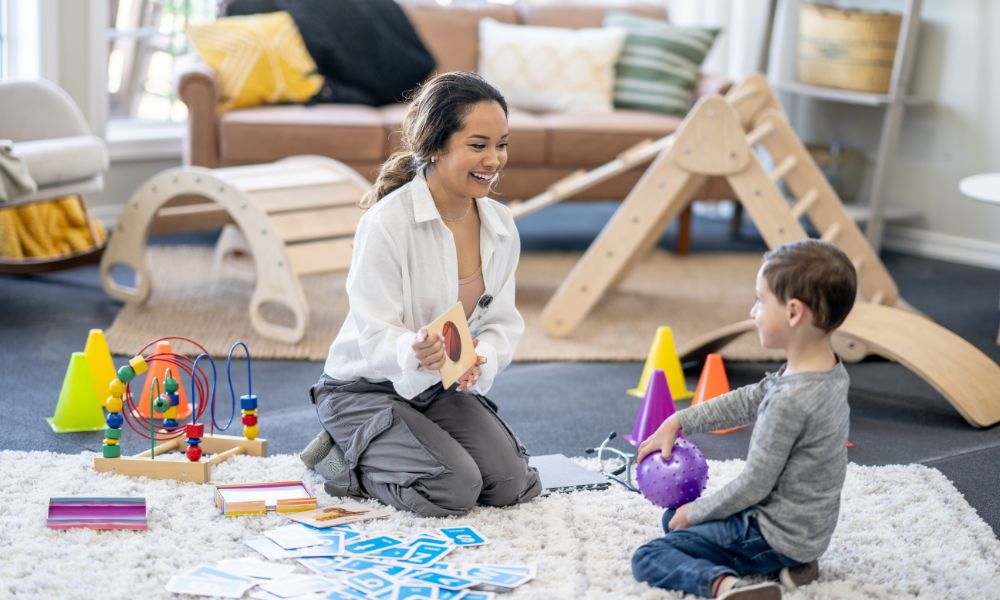The Complete Guide to Implementing ABA at Home: 15 Essential Strategies for Success
While traditional therapy settings have their place, the most profound breakthroughs in Applied Behavior Analysis (ABA) often happen right in the family living room. Research shows that children who receive consistent ABA support at home can make up to twice the progress compared to those who only receive clinical therapy.
The key to successful home-based ABA lies not in replicating a clinical environment, but in transforming everyday moments into powerful learning opportunities. From morning routines to bedtime rituals, parents have countless chances to reinforce positive behaviors and build essential skills—all within the comfort and familiarity of their own home.
Table of Contents
ToggleIntroduction to ABA and Its Benefits
Applied Behavior Analysis (evidence-based approach) is a scientific method for changing behavior through structured interventions. This evidence-based approach helps children with autism develop social skills, improve communication, and build essential life skills. Leading medical organizations, including the U.S. Surgeon General and American Psychiatric Association, recognize ABA as an effective treatment for addressing behavioral challenges in autism spectrum disorder.
Setting Up a Conducive Environment for ABA at Home

Creating a dedicated therapy space helps children focus during ABA sessions. Select a quiet area with minimal decorations and organize therapy materials within easy reach. Install visual schedules and communication boards on walls, and incorporate sensory tools like weighted blankets. Managing environmental factors such as lighting and temperature supports optimal learning conditions.
Read More: How to Create a Supportive Home Environment for ABA Therapy: A Comprehensive Guide
Identifying Target Behaviors and Skills
When starting ABA therapy at home, select specific behaviors to address based on your child’s needs. Common focus areas include teaching communication methods, building social interaction skills, and mastering daily living tasks. Work with ABA professionals to break these skills into small, achievable steps that match your child’s current abilities and development level.
Creating a Structured Routine and Schedule
Regular daily schedules support successful ABA implementation at home. Start by establishing set times for therapy sessions, meals, and activities. Use visual schedules to help your child understand daily expectations. Parents can support learning by incorporating ABA techniques into everyday activities like getting dressed, mealtime, and playtime.
Implementing Positive Reinforcement Techniques
When children show desired behaviors, providing immediate rewards and supports strengthens those actions. Simple gestures like specific praise (“Great job using your words!”) or tangible rewards make activities meaningful. Parents should maintain steady reinforcement patterns and select motivating items based on their child’s interests. Remember that effective rewards vary by child – while some respond to stickers, others prefer extra playtime or favorite snacks.
Using Prompts and Cues Effectively
Physical guidance, verbal instructions, and visual aids form the foundation of ABA prompting strategies. Start with clear support methods, then gradually reduce assistance as your child masters each skill. For example, begin with hand-over-hand guidance for tooth brushing, then shift to pointing at steps on a visual chart. This systematic reduction in support helps prevent over-reliance on prompts while building independent skills.
Breaking Down Tasks into Manageable Steps
Task analysis forms a central part of ABA implementation at home. Parents can split complex activities, like handwashing or getting dressed, into smaller sequential actions. For example, tooth brushing breaks down into: picking up toothbrush, applying toothpaste, brushing each section of teeth, and rinsing. Teaching one step at a time allows children to practice specific movements until they gain confidence in the full routine.
Incorporating ABA into Daily Activities and Play

Parents can turn common household activities into learning moments. During meals, practice requesting foods and utensils. Bath time offers chances to build vocabulary and following directions. Playtime activities like building blocks or board games create natural settings for turn-taking and social interaction.
Through structured play sessions, parents model appropriate behaviors and responses. A simple game of catch becomes an opportunity to practice eye contact and communication. Setting up pretend scenarios – like a toy store or restaurant – helps children practice social scripts and money skills in a low-pressure setting.
Read More: How Many ABA Therapy Hours Are Needed? A Guide for Families in Atlanta
Data Collection and Progress Tracking
Systematic data recording helps parents measure their child’s development during ABA therapy strategies during home-based ABA therapy. Using simple charts or digital apps, track specific behaviors, noting frequency, duration, and circumstances. Common recording methods include tally marks for discrete actions and ABC charts documenting antecedents, behaviors, and consequences. Parents can share this information with ABA professionals to adjust teaching strategies based on measurable outcomes.
Collaborating with Professional ABA Therapists
Professional ABA therapists provide essential guidance for parents implementing therapy at home. They assess children’s needs, design personalized intervention plans, and train family members in proper techniques. These specialists observe home sessions, adjust teaching strategies, and help parents master basic behavioral principles.
Weekly meetings allow therapists to review progress data, modify goals, and address challenges. Parents can prepare questions about specific behaviors or situations, share video recordings of home sessions, and request demonstrations of new techniques.
To find qualified providers, contact autism support organizations, ask pediatricians for referrals, or check the Behavior Analyst Certification Board directory. Look for therapists who hold current certifications and have experience working with your child’s age group.
Adapting ABA Strategies for Different Age Groups

ABA methods require specific modifications based on a child’s developmental stage. For toddlers (ages 2-3), therapy focuses on basic communication, imitation, and play skills through simple, repetitive activities. Parents can use songs, movement games, and colorful objects to maintain attention.
School-age children (ages 4-12) benefit from ABA techniques that incorporate academic and social components. Teaching methods might include peer interaction activities, structured learning tasks, and role-playing scenarios. Parents can integrate grade-level materials and interests into therapy sessions.
Read More: How To Manage Problem Behaviors in Public: ABA Strategies
Managing Challenging Behaviors at Home
When implementing ABA techniques at home, parents often face behaviors like tantrums, aggression, or self-injury. The ABC method (Antecedent-Behavior-Consequence) helps identify what triggers these actions. Watch for patterns in time of day, social situations, or environmental factors that occur before difficult moments.
Record specific details about challenging behaviors, including their frequency and intensity. This data helps spot patterns and adjust responses. Keep consistent boundaries while offering alternative ways to express needs. For instance, teach children to request breaks using picture cards instead of acting out.
Promoting Generalization of Skills Across Settings
Teaching skills that carry over into different environments stands as a key goal of home-based ABA therapy implementation. Children need to apply their learned behaviors beyond the therapy room – at school, in stores, or during family visits. Parents can support this transfer by practicing skills in multiple settings with different people.
Start small by moving activities to various rooms in the house. Once a child masters hand-washing in the main bathroom, try the same routine in other bathrooms. Next, expand to public restrooms during quiet times. This gradual expansion helps children adjust to environmental changes while maintaining learned skills.
Include family members and friends in practice sessions to build flexibility with different communication partners. A child who requests snacks from mom should also learn to ask dad, grandparents, or teachers using the same methods.
Involving Siblings and Other Family Members in ABA

Family participation strengthens ABA therapy outcomes at home. Siblings can model appropriate behaviors, practice social skills, and join learning activities. During playtime, brothers and sisters demonstrate turn-taking, sharing, and conversation skills that support their sibling’s development.
Parents can assign simple helper roles to family members, such as holding flash cards or giving high-fives for completed tasks. This shared responsibility creates natural opportunities for social interaction while building family bonds through positive experiences.
Self-Care Tips for Parents and Caregivers
Parents managing home-based ABA therapy programs need consistent self-care practices. Schedule regular breaks during therapy sessions, even if just for 5-10 minutes. Join local support groups to connect with others implementing ABA techniques at home. Set realistic daily goals and acknowledge small wins in your child’s progress.
Use respite care services when available to take needed time off. Build a network of trusted caregivers who understand ABA methods and can provide relief. Remember that maintaining your physical and mental health directly affects your ability to support your child’s development.
Common Challenges and Troubleshooting in Home-Based ABA
Parents conducting ABA therapy at home often face difficulties maintaining consistent schedules and managing behavioral responses. Common obstacles include resistance to activities, inconsistent progress, and difficulty generalizing skills across settings. When children show limited interest in reinforcers or become frustrated during tasks, parents can modify teaching approaches and adjust reward systems based on their child’s current needs and preferences.
For example, if a child stops responding to sticker rewards, switching to earned screen time or special activities might renew motivation. Breaking tasks into smaller steps helps when children feel overwhelmed by complex activities.
Read More: Home-Based vs. Center-Based ABA Therapy in Atlanta: A Comprehensive Guide to Making the Right Choice
Resources for Further Support and Education on ABA
Parents seeking additional knowledge about home-based ABA therapy can access professional training through behavioral health organizations. The Behavior Analyst Certification Board website lists certified workshops and online courses. Local autism centers often provide hands-on parent training sessions focused on practical implementation.
Online parent communities on platforms like Facebook and Reddit offer spaces to share experiences with ABA methods. Local support groups through hospitals and therapy centers connect families practicing similar techniques.
The Association for Science in Autism Treatment maintains a database of research-based materials and treatment guides for home programs. Parents can borrow ABA materials through lending libraries at autism resource centers.
Embracing the Journey of Home-Based ABA
Implementing ABA at home represents more than just therapy—it’s a transformative approach that weaves behavioral science into the fabric of daily family life. While the journey requires dedication, patience, and continuous learning, the rewards of seeing your child develop new skills and confidence make every effort worthwhile.
Remember that success in home-based ABA isn’t measured solely by mastered skills, but by the strengthened bonds and deeper understanding that emerge between family members. With consistent application of ABA principles, support from professionals, and a commitment to learning, parents can create a nurturing environment where their child thrives.
Sources
Cleveland Clinic – Applied Behavior Analysis (ABA) https://my.clevelandclinic.org/health/treatments/25197-applied-behavior-analysis
Applied Behavior Analysis (ABA) : https://asatonline.org/for-parents/learn-more-about-specific-treatments/applied-behavior-analysis-aba/
Treating Challenging Behaviors: https://autism.org/treating-behavioral-issues/
Behavioral Management Therapy for Autism: https://www.nichd.nih.gov/health/topics/autism/conditioninfo/treatments/behavioral-management
Managing a Home-Based ABA Program: https://asatonline.org/research-treatment/clinical-corner/managing-home-based-aba-program/
How to Work With Your Child’s ABA Therapist Effectively: https://researchautism.org/blog/how-to-work-with-your-childs-aba-therapist-effectively/
BEHAVIORAL TREATMENT OF AUTISM AND OTHER DEVELOPMENTAL DISABILITIES: https://www.bacb.com/about-behavior-analysis/treatment-of-autism-and-other-developmental-disabilities/

